Ethiopian Calendar
The Ethiopian calendar is much more similar to the Egyptian Coptic calendar having a year of 13 months, 365 days and 366 days in a leap year (every fourth year) and it is much influenced by the Ethiopian Orthodox Tewahedo Church, which follows its ancient calendar rules and beliefs. The Ethiopian calendar is always seven years and eight months behind the Gregorian (Western) and Eastern Orthodox Church calendars during September and December and eight years and four months behind during January and August. Therefore, the Ethiopians will celebrate the new millennium on September 1, 2000 Ethiopian calendar (September 12, 2007 Gregorian calendar).
Pope Gregory XIII reformed the Julian calendar due to the fact that Easter was drifting away from its springtime origins and so lost its relation with the Jewish Passover. Since 1582, the Gregorian (Western) calendar has become the religious, cultural and civil calendar for most of the world. Because of the ideological differences, the Eastern Orthodox Churches and Ethiopian Orthodox Tewahedo Church did not accept the Gregorian calendar and continued to use the Julian calendar with lunar tables for calculating Easter, together with other religious and cultural holidays.
The date of Christmas in the Ethiopian calendar always falls on December 29, but this date is January 7 in the Gregorian calendar i.e. 13 days after the Roman Catholic and Protestant Churches have celebrated their Christmas. However, the date of Easter in the Eastern, Coptic and Ethiopian Orthodox Tewahedo Churches’ calendars falls 7 days after the Jewish Passover which date determines the Roman Catholic and Protestant Churches’ Easter.
Although the Julian, Gregorian, Coptic and Ethiopian calendars have the same number of days in a year, (365 days and 366 days in a leap year), the counting systems giving the number of days in each month, and number of months in a year, of the Julian and Gregorian calendars differ from the Ethiopian and Egyptian Coptic calendars. The Ethiopian and Coptic calendars consist of 13 months where the first 12 months have 30 days each, and the Last (thirteenth) month has 5 days (6 days in a leap year). The Gregorian calendar consists of 12 months with January, March, May, July, August, October and December having 31 days, April, June, September and November, 30 days and February having 28 days (29 days in a leap year).
The Ethiopian New Year falls on September 11 (September 12 in the leap year) in the Gregorian calendar but it is September 1 in the Ethiopian calendar. In Ethiopia the first month of the year is September and the last (thirteenth) month of the year is Pagumiene, which comes after August. Each month has 30 days (from September to August) and the thirteenth month, Pagumiene, has 5 days (6 days in a leap year).
Ethiopian time is 3 hours ahead of GMT (Greenwich Mean Time) and is equally divided into day and night, each consisting of 12 hours from sunrise to sunset and vice-versa.
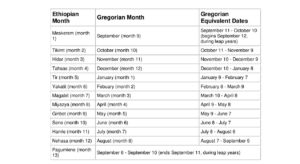
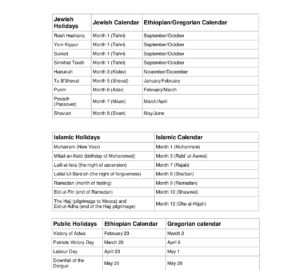
Religious Festivals
Religion plays an important part of life in Ethiopia. The Orthodox Tewahedo Church ceremonies are unique and impressive; especially Timket and Meskel festivals which provide colourful ceremonies and celebrations. People dress in traditional costume and celebrate festivals across the country with colourful unique ceremonies such as Enkutatash (New Year), Meskel (Finding of the True Cross), Ledet (Christmas), Timket (Epiphany ) and Fasika (Easter). Islamic tradition also celebrates religious festivals in the Ethiopian calendar, notably, Muharram, Milad-an-Nabi and Eid-ul-Fitr.
Enkutatash (New Year)
 Enkutatash (Ethiopian New Year) falls on September 1 Ethiopian calendar (September 11 Gregorian Calendar) at the end of the Ethiopian rain season.
Enkutatash (Ethiopian New Year) falls on September 1 Ethiopian calendar (September 11 Gregorian Calendar) at the end of the Ethiopian rain season.
Enkutatash means the “gift of jewels”. When the famous Queen of Sheba returned from her expensive jaunt to visit King Solomon in Jerusalem, her chiefs welcomed her bolts by replenishing her treasury with inku or jewels. The spring festival has been celebrated since these early times and as the rains come to their abrupt end, dancing and singing can be heard at every village in the green countryside.
But Enkutatash is not exclusively a religious holiday. Today’s Enkutatash is also the season for exchanging formal new year greetings and cards among the urban sophisticated – in lieu or the traditional bouquet of flowers.
Meskel (Finding of the True Cross)
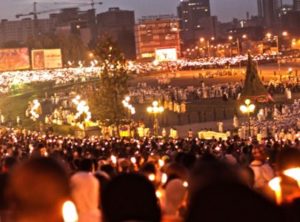 The feast is celebrated in Ethiopia on September 17 Ethiopian calendar (September 27 Gregorian calendar), Meskal has been celebrated in the country for over 1600 years. The word actually means “cross” and the feast commemorates the discovery of the cross upon which Jesus was crucified, by the Empress Helena, the mother of Constantine the Great. The original event took place on 19 March 326 AD. but the feast is now celebrated on 27 September.
The feast is celebrated in Ethiopia on September 17 Ethiopian calendar (September 27 Gregorian calendar), Meskal has been celebrated in the country for over 1600 years. The word actually means “cross” and the feast commemorates the discovery of the cross upon which Jesus was crucified, by the Empress Helena, the mother of Constantine the Great. The original event took place on 19 March 326 AD. but the feast is now celebrated on 27 September.
Many of the rites observed throughout the festival are said to be directly connected to the legend of Empress Helena. On the eve of Meskal, tall branches are tied together and yellow daisies, popularly called Meskal Flowers, are placed at the top. During the night those branches are gathered together in front of the compound gates and ignited – This symbolizes the actions of the Empress who, when no one would show the Holy Sepulcher, lit incense and prayed for help. Where the smoke drifted, she dug and found three roses. To one of the three, on the True Cross of Jesus, many miracles were attributed.
Meskal also signifies the physical presence of part of the True Cross at the church of Egziabher Ab, the remote mountain monastery of Gishen Mariam located 483 kms north of Addis Ababa in Wello administrative zone. In this monastery, there is a massive volume called the Tefut written during the reign of Zera Yacob (1434 – 1468), which records the story of how a fragment of the cross was acquired.
During this time of the year flowers gloom on mountain and plain and the meadows are yellow with the brilliant Meskal daisy. Dancing, feasting, merrymaking, bonfires and even gun salutes mark the occasion. The festival begins by planting a green tree on Meskal eve in town squares and village market places. Everyone brings a pole topped with Meskal daisies to form the towering pyramid that will be a beacon of flame. Torches of tree branches tied up together called “Chibo” are used to light the bundle called “Demera”.
Debra Damo (Feast of Saint Aregawi)
Orthodox Tewahedo Christians celebrate the feast of Saint (Abune) Aregawi, on October 14 Ethiopian calendar (October 24 Gregorian calendar) which culminates in a pilgrimage to Debra Damo, about 25 kilometres from Adigrat, from all over the country.
Kulubi (Feast of Saint Gabriel)
The feast of Saint Gabriel (kulubi Gebriel), the Archangel, is celebrated on December 19 Ethiopian calendar (December 28 Gregorian calendar) which culminates in a pilgrimage to Kulubi, about 68 kilometres from Dire Dawa. Orthodox Tewahedo Christians mark the celebration with colourful processions and ceremonies. Pilgrims walk up the hill to the church to fulfil a vow and give gifts to the church. Some pilgrims carry heavy rocks on their back up the hill to the church.
Ledet (Christmas)
Ledet (Christmas) falls on December 29 Ethiopian calendar (January 7 Gregorian calendar). Ledet (Christmas) , it is celebrated seriously by a church service that goes on throughout the night after 43 days fasting known as Tsome Gahad (Advent), with a spectacular procession, which begins at 6 AM and lasts until 9 AM. After the mass service, people go home to break the fast with the meat of chicken or lamb or beef accompanied with injera and the traditional drinks (i.e. tella or tej). Traditionally, young men played a game similar to hockey, called genna, on this day, and now Christmas has also come to be known by that name.
Timket (Epiphany)
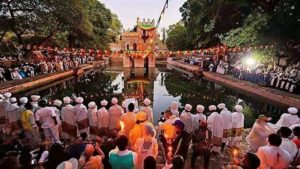 Timket (Epiphany) is one of the greatest festival in the Ethiopian Orthodox Tewahedo Church calendar. It commemorates Christ’s Baptism by Saint John in the Jordan River. Timket is celebrated in Ethiopia on January 11 Ethiopian calendar (January 19 Gregorian calendar), two weeks after Ledet (Ethiopian Christmas), beginning on the Eve of Timket with colourful processions and ceremonies ending on the January 12 (January 20 Gregorian calendar). In Timket, Tella and Tej are brewed, special bread is baked called “Himbash” (in Tigrigna) “Ambasha” (in Amharic), and sheep are slaughtered to mark the three-day celebration.
Timket (Epiphany) is one of the greatest festival in the Ethiopian Orthodox Tewahedo Church calendar. It commemorates Christ’s Baptism by Saint John in the Jordan River. Timket is celebrated in Ethiopia on January 11 Ethiopian calendar (January 19 Gregorian calendar), two weeks after Ledet (Ethiopian Christmas), beginning on the Eve of Timket with colourful processions and ceremonies ending on the January 12 (January 20 Gregorian calendar). In Timket, Tella and Tej are brewed, special bread is baked called “Himbash” (in Tigrigna) “Ambasha” (in Amharic), and sheep are slaughtered to mark the three-day celebration.
Fasika (Easter)
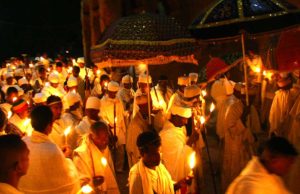 Fasika (Easter) is celebrated after 55 days severe Lent fasting (Hudade or Abye Tsome). Orthodox Tewahedo Christians do not eat meat and diary products for the whole 55 days. Vegetarian meals such as lentils, ground split peas, grains, fruit and varieties of vegetable stew accompanied by injera and/or bread are only eaten on these days. The fist meal of the day is taken after 3 PM (9 o’clock in the afternoon Ethiopian time) during the fasting days, except Saturdays and Sundays, where a meal is allowed after the morning service.
Fasika (Easter) is celebrated after 55 days severe Lent fasting (Hudade or Abye Tsome). Orthodox Tewahedo Christians do not eat meat and diary products for the whole 55 days. Vegetarian meals such as lentils, ground split peas, grains, fruit and varieties of vegetable stew accompanied by injera and/or bread are only eaten on these days. The fist meal of the day is taken after 3 PM (9 o’clock in the afternoon Ethiopian time) during the fasting days, except Saturdays and Sundays, where a meal is allowed after the morning service.
On Easter eve people go to church and celebrate with candles which are lit during a colourful Easter mass service which begins at about 6 PM (12 o’clock in the evening Ethiopian time) and ends at about 2 AM (8 o’clock after mid-night Ethiopian time). Everyone goes home to break the fast with the meat of chicken or lamb, slaughtered the previous night after 6 PM, accompanied with injera and traditional drinks (i.e. tella or tej). Like Christmas, Easter is also a day of family re-union, an expression of good wishes with exchange of gifts (i.e. lamb, goat or loaf of bread).
